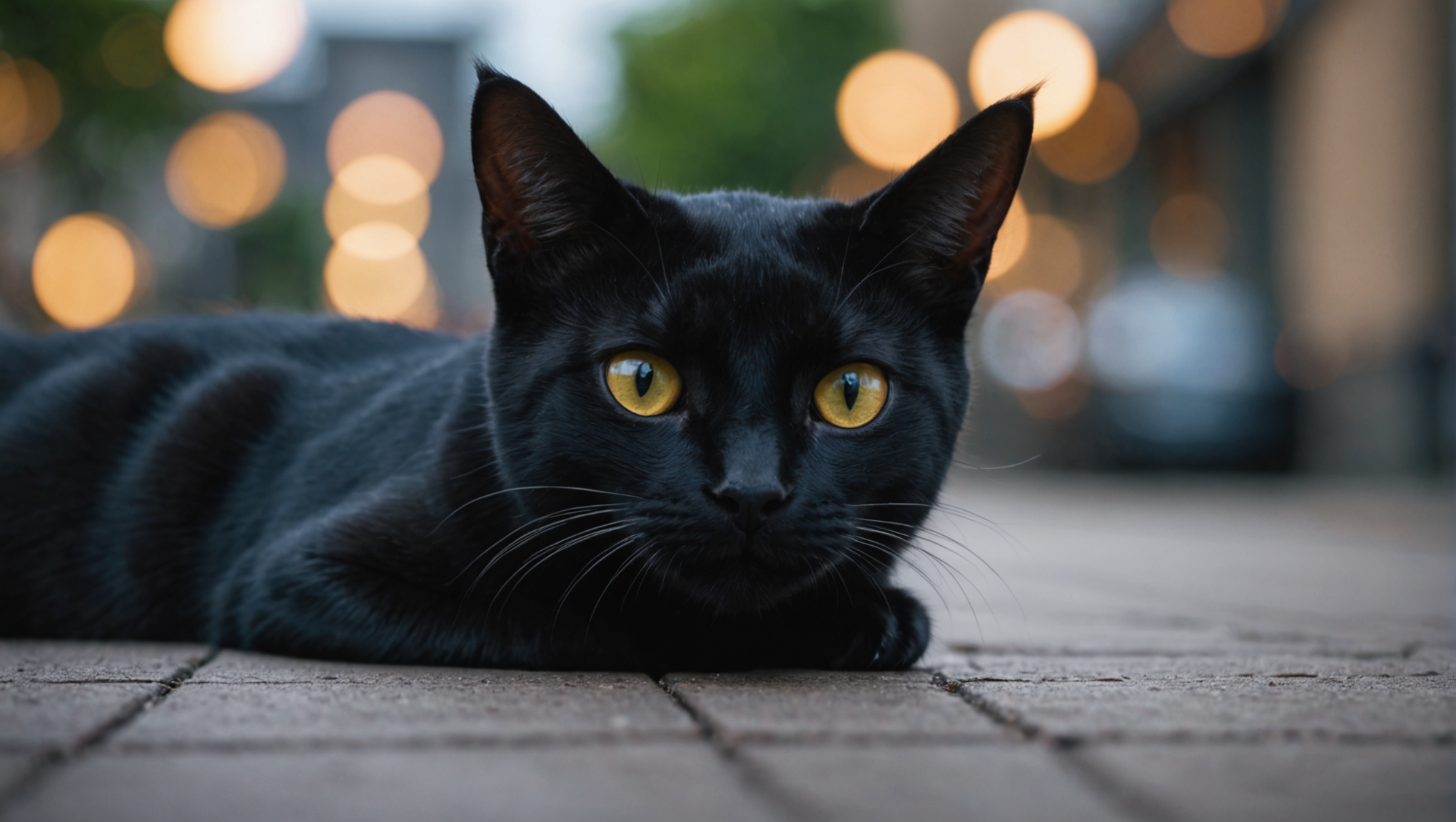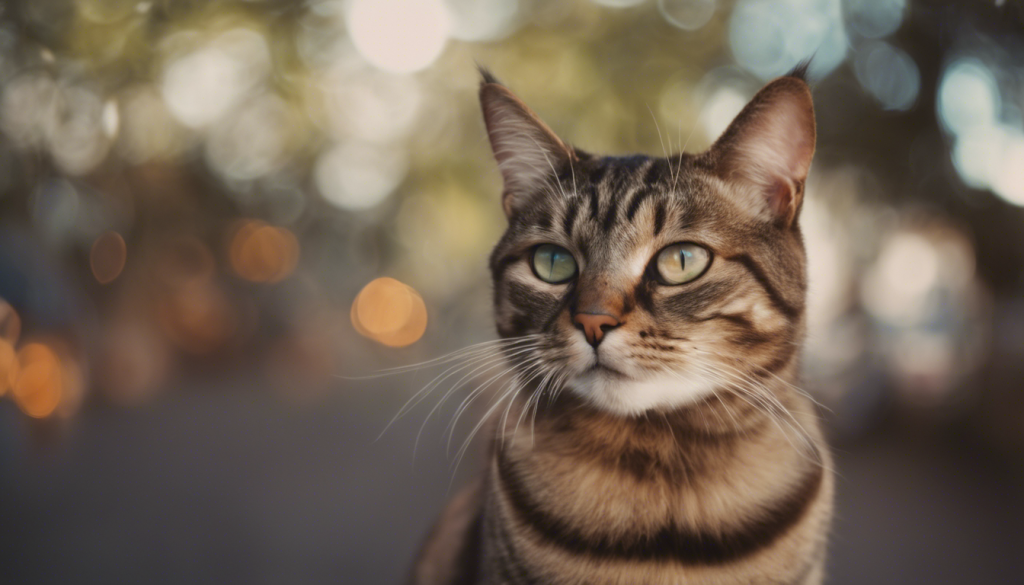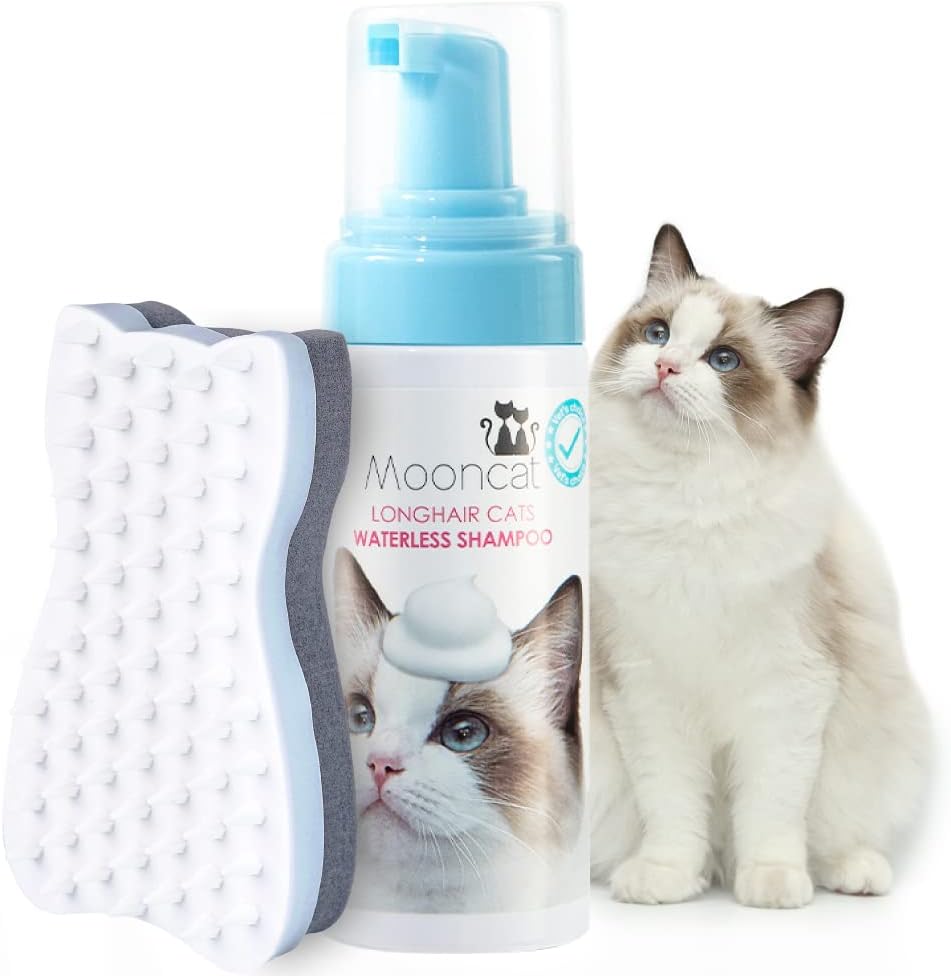
The Bombay cat breed, known for its striking appearance and playful disposition, has a relatively state-of-the-art genealogy that intertwines both luck and deliberate crossbreeding. This breed emerged in the United States during the mid-1950s, the brainchild of breeder Nikki Horner, who sought to create a breed that mimicked the appearance of a small, sleek black panther. To achieve this vision, she crossed the Burmese with the American Shorthair, thus laying the groundwork for what would become the beloved Bombay cat.
The breed’s name pays homage to the city of Bombay, now known as Mumbai, reflecting Nikki’s fascination with the exotic and the appeal of its namesake. This choice was also symbolic, as the black coat of the Bombay cat echoed the glossy fur of the wild panthers roaming the jungles of India. The first Bombay cat, a female named “Blackie,” showcased the breed’s desired traits and captivated the hearts of many cat enthusiasts, quickly propelling the breed into a popular status.
As breeders delved deeper into refining the breed’s characteristics, they worked diligently to enhance its physical traits, temperamental qualities, and overall health. The Bombay’s striking black coat, which has a unique sheen and a rounded head with wide-set eyes, garnered admiration for both its aesthetic and its affectionate nature. The breed was officially recognized by the Cat Fanciers’ Association (CFA) in 1976, marking a significant milestone in its evolution and acceptance within the feline community.
The modern-day Bombay cat exhibits a unique blend of playfulness, intelligence, and sociability, often forming close bonds with their human companions. They have the uncanny ability to adapt to various living situations, whether it be a bustling household or a serene apartment. Their playful antics and unwavering affection often resonate deeply with their owners, leading to a deep-rooted passion for the breed.
As the Bombay cat continued to garner popularity, it caught the attention of aspiring breeders across the globe, inspiring efforts to maintain and enhance its desirable traits. One of the focal points of breeding has been the commitment to ensuring not only the breed’s aesthetic allure but also its longevity and overall health. This attention to detail has helped solidify the Bombay cat’s reputation as a well-rounded companion, capable of providing joy and entertainment while still requiring responsible ownership and care.
In the decades that followed, the Bombay breed has seen an increase in registrations and a growth in dedicated enthusiasts. Its history is a testament to the ingenuity of breeding practices and the passion of those who have worked tirelessly to create and sustain this captivating breed. As a result, the Bombay cat stands as a symbol of how modern breeding can yield not just a beautiful animal but also a companion imbued with personality and charm.
Physical characteristics
The Bombay cat is a visual marvel, distinguished by its sleek, compact body and an alluring coat that gleams with a deep, rich black hue. The striking fur of the breed is short, dense, and often referred to as having a satin-like feel, making it not only captivating to the eye but also pleasant to the touch. Many Bombay cats exhibit an almost jet-black coat that showcases a vibrant luster under light, emphasizing their unique breed trait. This rich coloration, however, can sometimes present challenges in grooming; while it is low-maintenance compared to some long-haired counterparts, ensuring consistent upkeep is necessary to preserve its stunning appearance.
In terms of physical stature, the Bombay cat tends to be medium-sized, with a muscular build that suggests both agility and strength. Their slightly rounded head features prominent, wide-set eyes that are typically copper or gold in color, adding to their expressive and affectionate demeanor. The ears are medium-sized, rounded at the tips, and set wide apart, complementing the overall balance of their facial structure. This unique combination of features endows the Bombay with an almost kit-like allure, making it difficult for cat lovers to resist their playful antics and soulful gazes.
When it comes to behavior, the Bombay cat exemplifies a startling mixture of playful energy and endearing affection. These felines often exhibit a kitten-like demeanor throughout their lives, maintaining a zest for play that rivals even the most energetic breeds. Known for their intelligence, Bombays enjoy engaging in interactive play and benefit greatly from toys that challenge them mentally and physically. They thrive on attention and often seek companionship, making them ideal partners for families, singles, and even other pets.
However, with their vivacious nature comes a need for regular exercise. Bombay cats are not merely couch companions; they require ample physical activity to prevent boredom and associated behavioral issues. Incorporating daily play sessions and providing environments that stimulate their natural hunting instincts—such as scratching posts, climbing structures, and toys—will greatly contribute to their overall happiness.
Nonetheless, the breed is generally considered an indoor cat. Their curious nature can lead them into precarious situations outdoors, where they may encounter dangers such as cars or aggressive animals. Thus, creating a stimulating environment indoors especially important for their well-being. Enriching their space with perches by windows or safe access to cat trees can satisfy their inherent instinct to climb and observe their surroundings.
In terms of grooming, the Bombay cat is relatively easy to care for, requiring just weekly brushing to remove loose hair and maintain the coat’s sheen. This breed’s short hair and low shedding make them suitable for individuals with allergies, although it’s essential to recognize that no breed is completely hypoallergenic. Regular dental care and nail trimming are also necessary facets of grooming that will help keep your Bombay in optimal health.
Diet plays an equally pivotal role in the health and vigor of the Bombay cat. It is advisable to provide a high-quality, nutrient-dense diet suited to their age, weight, and activity level. Consulting with a veterinarian to determine the best dietary options is beneficial, as some Bombays may require specific adjustments based on their individual health needs. Offering a balanced diet rich in protein will nourish their muscular physique and support their energetic lifestyle, while ensuring access to fresh water will keep them hydrated and healthy.
By understanding and catering to the unique characteristics of the Bombay cat, owners can enhance their feline’s quality of life significantly. This breed, with its enchanting beauty and spirited nature, will not only embellish your home but also weave itself into the fabric of your family, offering affection, companionship, and an abundance of joyful moments that create lasting memories.
Temperament and behavior
The Bombay cat is renowned not just for its breathtaking appearance but also for its dynamic temperament and affectionate behavior, which have endeared it to families and cat aficionados alike. It’s a breed that thrives on human interaction, often forming deep and lasting bonds with its owners. This sociable nature means that Bombays will frequently follow their humans around the home, seeking companionship and participating in daily activities. They love to be involved, whether it’s lounging on your lap while you read, playing with children, or greeting visitors at the door, exhibiting a delightful blend of curiosity and friendliness.
Bombay cats tend to possess a playful disposition that remains intact well into adulthood, making them lifelong companions with a youthful energy. They have an insatiable enthusiasm for play, often engaging in games of chase or hide-and-seek. Their intelligence makes them quick learners, and they often enjoy interactive toys or puzzles that stimulate their minds. A challenging feather wand, laser pointer, or even simple cardboard boxes can spark their interest and encourage physical and mental engagement. This inherent playfulness is complemented by their agile movements, reminiscent of their wild ancestors, making them a joy to observe.
While their active nature contributes to the overall charm of the Bombay, it also emphasizes the necessity for structured playtime. Owners should aim to incorporate physical exercise into their daily routines, as an under-exercised Bombay cat may display behavioral issues such as excessive meowing or destructive tendencies. Regular play sessions, combined with opportunities for exploration and climbing within a safe environment, will help mitigate these issues while keeping your pet physically fit and mentally stimulated.
When it comes to their temperament, Bombays generally exhibit a confident and outgoing personality. They are known for being affectionate and enjoy cuddling and being held, often forging strong emotional connections with their families. This breed’s gentle and loving demeanor makes them particularly good with children, as they can tolerate the energy and unpredictability that often accompanies young ones. Furthermore, Bombays are typically very social with other pets, making integration into multi-pet households relatively seamless.
Another noteworthy aspect of the Bombay cat’s behavior involves their vocalization. While they’re not excessively loud, they do have a soft, expressive voice that they often use to communicate their needs and desires. Owners may find their Bombay engaging in conversations, particularly when they are seeking attention or food. This communicative trait adds another layer to their interactive nature, allowing for a rich exchange between feline and human.
Nonetheless, the cheerful and engaging behavior of the Bombay can be complemented by a touch of independence. While they thrive on companionship, they’re also capable of entertaining themselves when necessary. Providing access to stimulating toys and perches can ensure that they remain entertained when their humans are unavailable. However, it is essential to strike a balance between independence and interaction, as too much solitary time can lead to feelings of loneliness.
As with any breed, understanding individual personality traits is key to fostering a harmonious relationship with your Bombay. Each cat has its own unique quirks, and taking the time to discover their likes and dislikes can lead to a fulfilling companionship that both owner and pet can cherish. Whether it is a preference for a specific type of play or a chosen napping spot in a sunny window, attentive observation will enrich the bond between you and your Bombay.
To support the emotional well-being of the Bombay cat, consistency in routine is important. Establishing regular feeding, playtime, and cuddle sessions can provide comfort and a sense of security. Creating an environment that’s enriched with diverse stimuli—like climbing structures, interactive toys, and safe places to retreat—will also contribute to a thriving, happy Bombay. This breed not only blossoms with care and affection but also flourishes when it feels confident, engaged, and cherished within its home.
Care and grooming
To ensure the health and happiness of your Bombay cat, diligent attention to care and grooming is imperative, embracing both the physical and emotional needs that define this captivating breed. The Bombay, with its short, dense coat, is relatively low in grooming demands, yet a consistent routine will not only enhance the luster of their striking black fur but also contribute to their overall well-being.
Brushing your Bombay cat at least once a week is recommended. This practice not only helps to remove loose hairs but also stimulates the skin and distributes natural oils, maintaining the coat’s gleaming sheen. A soft-bristle brush or a grooming glove works effectively, allowing for a gentle yet thorough grooming session that your Bombay will likely enjoy. While their short hair means they’re less prone to matting compared to long-haired breeds, regular grooming can minimize hairballs, a common issue in cats.
In addition to brushing, it’s important to incorporate dental care into your grooming regimen. Dental disease is a prevalent condition among cats, and the Bombay is no exception. Regularly brushing your cat’s teeth—ideally using a pet-safe toothpaste—and providing dental treats will help promote oral health. Additionally, your veterinarian may recommend professional cleanings to prevent the buildup of tartar and maintain fresh breath.
Bathing a Bombay cat is generally unnecessary, as their skin produces oils that help keep their coat clean and healthy. However, if they happen to get into something particularly messy, a gentle bath using a cat-specific shampoo can be conducted. Be sure to dry them thoroughly and keep in mind that frequent bathing is not advisable, as it can strip their coat of essential oils.
Nail trimming is another important aspect of grooming that should not be overlooked. Regular nail clippings—ideally every two to three weeks—will prevent splitting and discomfort while also protecting your furnishings and maintaining a safe environment. Introducing nail clippers gradually during grooming sessions allows your Bombay to become accustomed to the process, minimizing any potential stress or resistance.
The Bombay cat, with its lively character and affectionate disposition, thrives on routine and interaction. Engaging your Bombay in regular playtime activities will not only cater to their exercise needs but also fortify your bond. Daily sessions with interactive toys—such as feather wands, laser pointers, or even simple cardboard boxes—will provide the mental and physical stimulation this is vital for their energetic spirit. Scheduling specific play periods fosters predictability in their lives, alleviating any anxiety they may feel in the absence of structured activities.
Moreover, a healthy diet tailored to their lifestyle is fundamental in maintaining the vitality of the Bombay. High-quality cat food, rich in protein and essential nutrients, is important to their muscular build and active disposition. Consult with your veterinarian for tailored dietary advice, as factors such as age, weight, and health conditions may necessitate specific dietary adjustments. Fresh water should always be available, and incorporating wet food into their diet can provide hydration as well as variety.
As a breed often prone to specific health concerns such as respiratory issues, heart problems, and obesity, regular veterinary check-ups are paramount. These visits will allow for early detection and management of any potential health concerns, ensuring that your Bombay remains a lively and integral part of your family. Keeping your cat engaged and enriched, both physically and mentally, is essential for a healthy, thriving Bombay.
Lastly, understanding the individual needs and particularities of your Bombay cat can significantly enhance the caregiving experience. Each feline possesses its unique personality traits, and recognizing their preferences for play, cuddling, or relaxation can lead to an enriching companionship. Creating a nurturing environment that reflects love, care, and understanding will allow your Bombay to flourish, becoming not only a cherished pet but an irreplaceable member of your household.
Health considerations
When it comes to the health considerations of the Bombay cat, vigilance and proactive management are of utmost importance to ensure a long, fulfilling life for your feline companion. As a breed, Bombays can be predisposed to some health conditions, and nurturing them requires a keen understanding of these potential issues along with a commitment to preventive care.
One of the primary health concerns that may affect Bombays is hypertrophic cardiomyopathy (HCM), a genetic condition that leads to the thickening of the heart muscle. This condition can be particularly prevalent in Burmese and breeds closely related to them, including the Bombay. Regular veterinary check-ups are essential for early detection, as the symptoms can often be subtle. Routine heart screenings and echocardiograms as recommended by your veterinarian can provide peace of mind and catch any issues before they progress to more serious stages.
Another concern is obesity, which can be exacerbated by the Bombay’s relatively sedentary lifestyle if not properly stimulated. Bombays have a sturdy, muscular build that can mask weight gain, making it essential to watch their diet and activity levels. Providing a balanced diet with appropriate portion control is important. Engage your Bombay in regular play to maintain their weight and safeguard their overall health. Interactive play sessions not only help burn calories but also cater to their playful nature and need for mental stimulation.
Additionally, some Bombays may experience dental issues due to their genetic predisposition, and it is vital to incorporate dental care into their routine. Periodontal disease can lead to significant discomfort and impact other systems if left unaddressed. Regularly brushing their teeth, along with dental treats or toys designed to promote oral health, can effectively reduce the risk of dental diseases. Annual veterinary dental cleanings will also contribute to maintaining optimal oral hygiene.
Eye health is another aspect warranting attention. Bombay cats are typically known for their striking, expressive eyes, but they can be susceptible to certain eye conditions. Regular examinations can help identify issues such as conjunctivitis or other ocular concerns early on. Be observant for signs of irritation, discharge, or changes in behavior that might suggest discomfort.
The Bombay’s short coat may limit grooming needs, yet paying attention to their skin and fur is important as well. Regular brushing not only keeps the coat shiny but also allows for the detection of fleas, ticks, or skin irritations. Monitoring for any changes in skin condition, such as redness or excessive scratching, can help tackle potential issues before they escalate—always consult your veterinarian if you notice anything unusual.
Moreover, finding a high-quality, nutritionally balanced diet tailored to the Bombay’s unique requirements plays a significant role in promoting their health. A diet rich in protein and other essential nutrients will support their active lifestyle, and routinely changing their diet without consulting a veterinarian can lead to gastrointestinal distress. Always introduce new foods gradually to help avoid digestive upset.
In terms of exercise, it especially important to promote daily physical activity to stave off obesity and maintain cardiovascular health. Bombays’ intelligence craves mental engagement, so incorporating puzzle feeders or toys that challenge them mentally will further enhance their well-being. A stimulating environment can deter boredom, which sometimes leads to destructive behavior—be sure to provide various toys and climbing structures that invite exploration.
Preventive healthcare should also cover vaccinations and parasite control, which are essential for maintaining overall health. Regular vet visits ensure that your Bombay receives all necessary vaccinations, while monitoring for common parasites such as fleas, ticks, and worms. Following the recommeded schedule as outlined by your veterinarian can avert potential health issues before they arise.
The key to enjoying a long and healthy life with your Bombay lies in consistent veterinary care, proactive monitoring for specific health issues, a balanced diet, and regular physical and mental stimulation. By adopting a holistic approach that prioritizes both health and happiness, you can cultivate a supportive and nurturing home, allowing your Bombay cat to thrive as a cherished member of your family.







